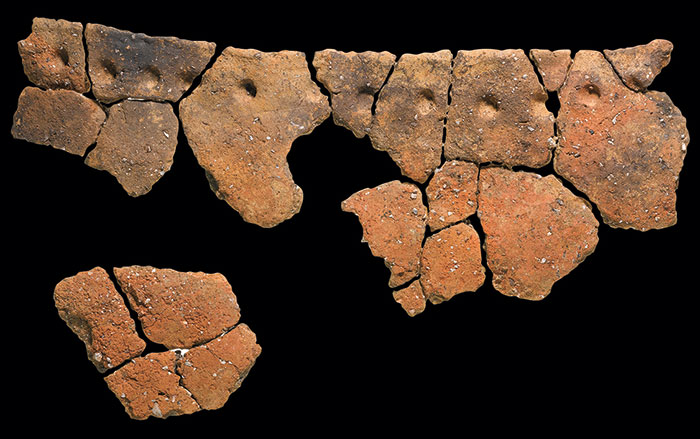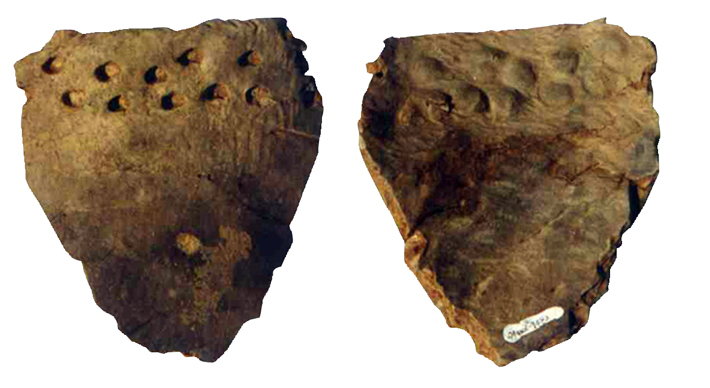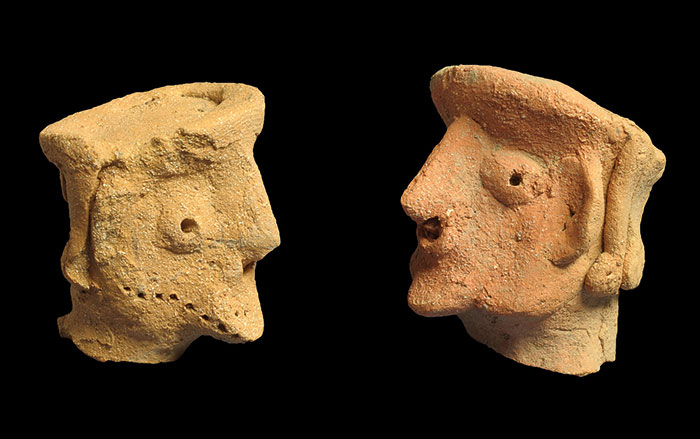
Since first being unearthed in New Mexico in the late nineteenth century, the striking ceramic bowls made a millennium earlier by people living in the Mimbres River Valley of the American Southwest have inspired countless counterfeiters, a clay art festival, a burglary at the University of Minnesota’s anthropology department, and even a line of railroad dinnerware.
While their undecorated outsides appear unremarkable in technique and form, their insides are magic, a canvas for haunting depictions of tortoises, fish, jackrabbits, and sometimes humans, as well as intricate geometric designs. The black forms on a white background create an arresting contrast.
For more than a century, beginning in the late tenth century A.D., thousands of these black-on-white bowls were produced, with distinctive designs more spectacular and elaborate than those of any other culture in the Southwest. “It was strikingly unique,” says Steve LeBlanc, an archaeologist at the Peabody Museum of Archaeology and Ethnology at Harvard University, who has studied the pottery makers since the 1970s.The figurative painting on the bowls—sophisticated composite animals and complex scenes and stories—sets Mimbres pottery apart from that of neighboring cultures, where geometric shapes dominated. Then, in 1130, according to the archaeological record, the manufacture of the bowls stopped.

The Mimbres lived in an area that today is nestled in New Mexico’s southwest corner, spilling over the border there with Arizona, and dipping into the Mexican state of Chihuahua. Archaeologists consider Mimbres a subset of the Mogollon culture. Mogollon is one of three major cultures of the ancient American Southwest, along with the Anasazi, also referred to as the Ancestral Pueblo, and the Hohokam. The Ancestral Pueblo are known for large, sophisticated village sites and road systems, such as Pueblo Bonito at Chaco Canyon. The Hohokam engineered complex irrigation canals, unrivaled by other pre-Columbian cultures in North America. Traced to a.d. 200, the Mogollon stretched across the mountainous region near today’s Mexican-American border, living in semiunderground dwellings. Overall, they did not farm intensively. The Mimbres, however, used irrigation methods similar to those of the Hohokam to exploit the fertile floodplains of the Mimbres River in order to produce corn, squash, beans, and other crops.

The Mimbres River, named by the Spanish for the willows that grew along its banks, was an oasis in the dry Southwest where rain clouds cross west to east over the peak of Black Mountain before shedding their rain. The Mimbres region stretched east to the Rio Grande and west to the Gila River Valley, in what is today southwestern Arizona. The years between A.D. 1000 and 1130 mark the culture’s apex, called the Mimbres Classic period. People built pueblos, living in densely packed villages along the Mimbres River Valley, with a large increase in population during that time bringing their total numbers as high as 6,000.
Archaeological investigation of the Mimbres began with early digs by independent archaeologists Burt and Hattie Cosgrove around 1919. Their foundational work soon resulted in Harvard’s Peabody Museum asking the pair to lead detailed excavations at the Swarts Ranch site in southern New Mexico. Their investigation lasted from 1924 to 1927 and included the recovery of almost 700 Classic black-on-white bowls. The pots were so impressive that pothunters were gutting other sites, often on private land. The Swarts Ranch site was chosen because it was relatively intact.
Thereafter, archaeological work stalled until the 1970s, though looting of Mimbres sites persisted. When pothunters began to use heavy machinery in the 1970s, destroying sites in the process, LeBlanc formed the Mimbres Foundation, which helped restart work on the culture at sites such as Mattocks Ruin in the southwestern corner of New Mexico. At many of the newly studied sites, archaeologists recovered burned roof rafters, which they think might have been part of a ritual involved in closing a settlement. Tree ring analysis of the charcoal returned a series of dates that ended at a.d. 1130. “It wasn’t until about 1974 or 1975 when we got the first tree ring dates back, and the terminal date of 1130, that we began to ask, what happened?” LeBlanc says.

Since then, the prevailing view of researchers was to read the break in the archaeological record as a systemic social collapse—depopulation accompanying the abandonment of a site. Others, such as Margaret Nelson, an archaeologist at Arizona State University (ASU) who began studying the pottery makers as a graduate student in the 1970s, have a different interpretation. For Nelson and her ASU colleague Michelle Hegmon, the sudden cessation of Mimbres pottery production, though abrupt in the archaeological record, doesn’t necessarily point to the end of the Mimbres culture.
“We like that pottery, we call them the Mimbres people, and they became a famous archaeological case. But people are always changing their styles,” Hegmon says. “I’m not sure it was as big a change for them as it was for us.”

The first decorations on Mimbres pottery—simple geometric shapes in red on brown clay—appear around A.D. 600. The potters developed the black-on-white style, an artistically pleasing contrast found in much Southwest pottery, 150 years later. By about the late 900s, the exceptional design that came to define the Mimbres Classic period took off.
Mimbres artists painted geometric lines and patterns on two-thirds of the bowls found and figures on about one-third. They smoothed the insides with stones, applying a fine white clay slip over brown clay, and then brushed on black paint made by mixing ground iron ore and a plant-derived binder, probably with yucca brushes. Animals depicted include prey species such as deer, pronghorns, and jackrabbits; insects such as grasshoppers; spiders; snakes; and fish. They also painted feathered serpents and other mythical creatures. They portrayed ceremonial and everyday human scenes, too: a ritual dancer; a hunter bringing home a kill, trailed by dogs; a mother birthing a baby. The bowls apparently were not traded, as they rarely turn up outside Mimbres sites.
Indications from use suggest that though thoughtfully created, the bowls were not the equivalent of heirloom fine china, carefully stashed away for a grand event. Marks found on their interiors suggest they were scraped by people using spoons, which were probably made from gourd or wood since none survive. The bowls measure roughly four inches tall and vary from six to 16 inches in diameter. The large range of sizes suggests multiple functions, among them serving and eating. In fact, the people even buried their dead—under their living areas—with the bowls placed on skulls. The bowls found with skulls have a “kill hole” in the middle tapped out by a sharp object, perhaps as a way for a spirit to rise out. At Swarts, the Cosgroves recorded 1,009 such burials.
Jars, not as carefully made, and only occasionally found intact, are more often unpainted plain brownware. It’s probable, LeBlanc says, that few potters would bother to decorate a pot for cooking over a fire or one shoved in a corner with beans stored inside. Jars were large enough to hold a gallon or two of water, or small, a couple of inches across, just big enough for seed storage. “We find jars basically as sherds,” LeBlanc says. “The number of complete examples of large painted water jars, for example, is 10 or 15, something like that, versus 10,000 bowls.”

LeBlanc notes that researchers have yet to locate the sources of the clay used in Mimbres pottery, although a technique called instrumental neutron activation (bombarding small sherd samples with neutrons to reveal the clay’s chemical composition) reveals that the clay came from a local source. “Clay is heavy stuff,” LeBlanc says. “I would be surprised if they were going farther than a couple of miles to get it.”
In the early twelfth century, after a few generations of favorable climate conditions, the drought-prone Southwest experienced another dry spell. Faunal remains indicate that big game species such as deer and pronghorn may have already been scarce throughout the Classic period. But, despite the drought, the people could apparently still grow crops. Scientists have taken soils from terraced fields back to the lab and been able to grow corn in them.
Within the Mimbres region responses to the climatic shift differed. Signs of Mimbres architecture and pottery peter out in the Gila River drainage before A.D. 1100. Stephen Lekson, an archaeologist at the University of Colorado Boulder who worked in the Mimbres region with Nelson in the 1980s, believes many of the Mimbres Valley dwellers steadily headed south through a series of post–Classic period villages.
For the past two decades Nelson and Hegmon have concentrated their digs in the east, a promising area, less ransacked by pothunters than the main valley. As part of the Eastern Mimbres Archaeological Project, the archaeologists excavated at least a dozen sites, including five Classic villages and smaller sites located about one and a half miles from them. Results from their digs indicate the people adapted to changes in their climate and reorganized their social structure.
Nelson and Hegmon’s fieldwork revealed a pattern repeated in the smaller eastern Mimbres sites. They were finding rooms often the size of a single-car garage and big enough for a small family to live in, with hearths, food grinding areas, and ventilation. One well-preserved structure was uncovered at nearby Mountain Lion Hamlet, which sits above the Palomas Creek drainage just south of the town of Truth or Consequences, New Mexico. The site was named for a petroglyph of a four-legged creature that a wildlife biologist pointed out had a long tail like that of a mountain lion.
“We found masonry, four walls,” Hegmon says, also noting the presence of a cooking hearth, warming oven, and grinding feature. “It looked like a place where people lived year-round.” During their initial excavations in 1994, they found an evenly plastered floor about an inch or two thick with 16 postholes in it. The posts would have likely held up a roof made of beams and reeds. Masonry walls surrounding the floor were three to four feet high.
When Nelson and Hegmon’s team peeled back the masonry along one wall, they exposed vertical pole imprints from what they believe was an earlier, flimsier wall made of jacal, stick-scaffolding filled in with mud. Further excavation revealed a lower, unevenly plastered floor with patches of packed dirt that sat six inches below the upper floor. From evidence at other sites, the archaeologists believe that what initially stood before the four-walled room was a temporary three-walled jacal structure—a Classic-period field house used by farmers when tending crops during the growing season.

Nelson says the remodeling of the field houses is akin to having a lake house or cabin in the mountains that initially one only visits a few times per year. “If eventually you left your town and moved into the cabin, you might add a bunch of things that make it a more permanent house for you,” she explains. “That’s what we see happening for those who remained in the region but left their villages at the end of the Classic period.”
Carbon dating of the roof beams and corn remains, and analysis of obsidian artifacts such as projectile points and flakes, all confirm post–Classic dates at the renovated hamlets found at eastern Mimbres sites. The best dating, however, is the chronology of the ceramics found at places such as the largest Eastern Mimbres site, Lizard Terrace, which consists of 12 rooms on an upper terrace and 10 to 12 on a lower one.
On the upper—later—archaeological levels of the site’s quarters was a hodgepodge of pottery sherds from some of the most widely traded ceramics in the Southwest after 1150, including St. John’s polychrome, which is most commonly found in west-central New Mexico. The bowl interiors have a thick orange-red slip and black geometric, swirling, or angular designs. The exterior of St. John’s polychrome has a white, chalky paint with simpler patterns. Also found was El Paso polychrome, which is easily recognized by its “popcorn” temper—from embedded white stones on its surface—even if the paint has been worn away. On the lowest, bedrock-level floor, only Mimbres Classic black-on-white pottery was found.
Nelson and Hegmon’s finds are mirrored by recent work at the largest post–Classic Mimbres site, Black Mountain, poised at the southern end of the Mimbres Valley and occupied by A.D. 1200 and likely earlier. Archaeologists there have recovered a mix of pottery linked to regions in every direction.
Katy Putsavage, a doctoral student of Lekson’s, began excavations at Black Mountain in 2010, uncovering the remains of two large adobe pueblos with up to 200 rooms. Putsavage finished her digs last year and is currently analyzing the findings. The pottery has already offered some interesting insights. In addition to St. John’s and El Paso polychrome, Putsavage also found pottery typically associated with sites as far away as southern Chihuahua. The presence of very little Mimbres black-on-white is interpreted by Lekson as a rejection of the old ways.
“From pottery types we can tell there was an expansion of exchange networks after the Classic Mimbres,” Putsavage says. “I would be interested to see how the ceramics compare to the ceramics from earlier time periods in the Mimbres Valley. It’s possible that some of the pottery types were made from the same clay sources as earlier time periods.”

The Mimbres people went from creating and using only the iconic bowls that are the signature of their culture to using up to eight different types of pottery that were either imported from anywhere and everywhere or made as copies of the different styles.
Archaeologists’ next challenge is to figure out exactly which of those eight or so different painted wares were made locally and which were imported. The key will lie in determining the sources of each of the different painted ceramics. Nelson and Hegmon have already noted that some of the El Paso pots were made from local brown clays, sometimes less expertly, as if the potters were learning a new style.
“If they’re emulating the pottery, then they’re quite likely emulating a lot of other things that are connected to the people who make that pottery, and to the region where it’s made,” Nelson says. “That’s an important observation because it tells us about the social process for adopting a particular ceramic.”
Though a lot of ceramic analysis remains to be done, the assembled evidence from the eastern Mimbres River Valley and from southern sites such as Black Mountain argue for the Mimbres transitioning from a closed society making arresting works of art to well-networked importers of other traditions. “It always bothered me, the sense that if the pottery disappears the people disappear,” says Nelson. Lekson theorizes, though evidence is scant, that the bulk of the Mimbres settled in the Casas Grandes region, forming the base population for Paquimé, located in what is today northwestern Chihuahua, Mexico. Paquimé was the last major city in the Southwest prior to European contact in the fifteenth century.
“Who are these guys?” Lekson asks about the people who inhabited Black Mountain. “Same people, different clothes.”











